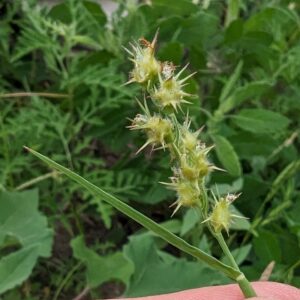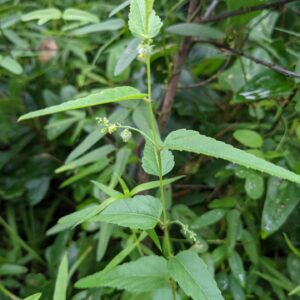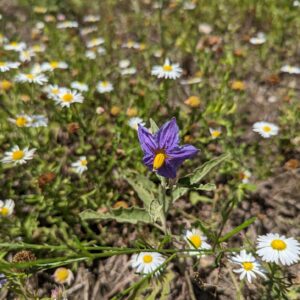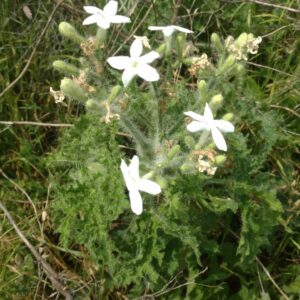For those new to gardening — or to Texas — there are a few plants to be mindful of when you set out to do yard work.
Malachi Leo, Planner in SAWS Conservation
Like many of us, some plants want personal space. But because they can’t talk, they must use other methods to set their boundaries. Methods that not only hurt your hands, but also your feelings.
For those new to gardening — or to Texas — there are some plants to be mindful of when you set out to do yardwork. South Texas trees, shrubs and cactus are famously strung with thorns and brambles. While thorns are relatively easy to spot, others are sneaky, teaching bare feet a memorable (and painful) lesson.
Today, we’re focusing on five prickly plants to keep eyes out for.
-
 Sandbur: Most everyone has childhood memories of pulling these stickers out of their feet or shoes. Sandburs don’t discriminate who they cling to. Annual weeds and prolific seed producers, they do especially well in the same setting as typical turf grass — the sandier the better. Getting rid of sandbur can require pre- and post-emergent treatment over multiple growing seasons. In the meantime, keep your mower blades clean to avoid spreading the seeds.
Sandbur: Most everyone has childhood memories of pulling these stickers out of their feet or shoes. Sandburs don’t discriminate who they cling to. Annual weeds and prolific seed producers, they do especially well in the same setting as typical turf grass — the sandier the better. Getting rid of sandbur can require pre- and post-emergent treatment over multiple growing seasons. In the meantime, keep your mower blades clean to avoid spreading the seeds. -
 Noseburn: So named for the irritation it causes to grazing animals, many noseburn species occur in the greater San Antonio region, but all are covered in little hairs that deliver a mix of irritating chemicals. Small and unassuming, they blend in with the grasses they grow alongside, and the first indication of their presence is often the stinging sensation they leave you with. (If you’ve ever walked in tall grass in shorts or sandals and felt a burning sensation, you’ve likely had a run-in with noseburn.) one good thing about noseburn: it’s the host plant for the common Mestra butterfly, so the next time you feel the sting, console yourself with the thought that you’re taking one for the caterpillar team.
Noseburn: So named for the irritation it causes to grazing animals, many noseburn species occur in the greater San Antonio region, but all are covered in little hairs that deliver a mix of irritating chemicals. Small and unassuming, they blend in with the grasses they grow alongside, and the first indication of their presence is often the stinging sensation they leave you with. (If you’ve ever walked in tall grass in shorts or sandals and felt a burning sensation, you’ve likely had a run-in with noseburn.) one good thing about noseburn: it’s the host plant for the common Mestra butterfly, so the next time you feel the sting, console yourself with the thought that you’re taking one for the caterpillar team. -
 Silverleaf nightshade packs a double whammy. This nightshade has lovely little flowers shaped like stars, which can be blue, lavender or white. But the striking yellow stamens and silver/grey leaves and stems not only deliver a sting, but make nightshade poisonous. Even worse, it grows well in poor soil and with little water, and mowing it can cause it to grow back stronger — with deeper roots, more spines and higher toxicity.
Silverleaf nightshade packs a double whammy. This nightshade has lovely little flowers shaped like stars, which can be blue, lavender or white. But the striking yellow stamens and silver/grey leaves and stems not only deliver a sting, but make nightshade poisonous. Even worse, it grows well in poor soil and with little water, and mowing it can cause it to grow back stronger — with deeper roots, more spines and higher toxicity. -
 Greenbriar: A vine that spreads aggressively, putting the thick in thicket. Spines are along the stems, and because it grows so quickly, can easily form large tangles of dense growth. Young shoots are food for goats and other animals. This plant is such an aggressive and fast-grower that it even makes its way into the tops of trees. While it can provide shelter for birds and food through the berries, it’s hard to stop it once it gets going.
Greenbriar: A vine that spreads aggressively, putting the thick in thicket. Spines are along the stems, and because it grows so quickly, can easily form large tangles of dense growth. Young shoots are food for goats and other animals. This plant is such an aggressive and fast-grower that it even makes its way into the tops of trees. While it can provide shelter for birds and food through the berries, it’s hard to stop it once it gets going. -
 Texas bullnettle: Don’t be fooled by its delicate white flowers. Texas bullnettle is as scary as it looks. Fully cloaked in spines, this plant does not want to be touched. Making contact with this plant can cause a painful sting that can be felt for an hour or longer, and to make matters worse, if the stem is broken it releases a milky white sap that can also cause an allergic reaction. Tough enough to be named after Texas — the plant thrives just fine in intense heat because of the extensive taproot system, which is an unbelievably large, thick tuber.
Texas bullnettle: Don’t be fooled by its delicate white flowers. Texas bullnettle is as scary as it looks. Fully cloaked in spines, this plant does not want to be touched. Making contact with this plant can cause a painful sting that can be felt for an hour or longer, and to make matters worse, if the stem is broken it releases a milky white sap that can also cause an allergic reaction. Tough enough to be named after Texas — the plant thrives just fine in intense heat because of the extensive taproot system, which is an unbelievably large, thick tuber.
At the end of the day, plants exist and adapt to survive and reproduce. The plants listed here grow the way they do to avoid being eaten, touched or otherwise disturbed.
Still, don’t let this deter you. With a little bit of research and the proper equipment, you can tackle any issue in your garden. Take a look at our coupons and rebates for some help on how to make the daunting doable.


